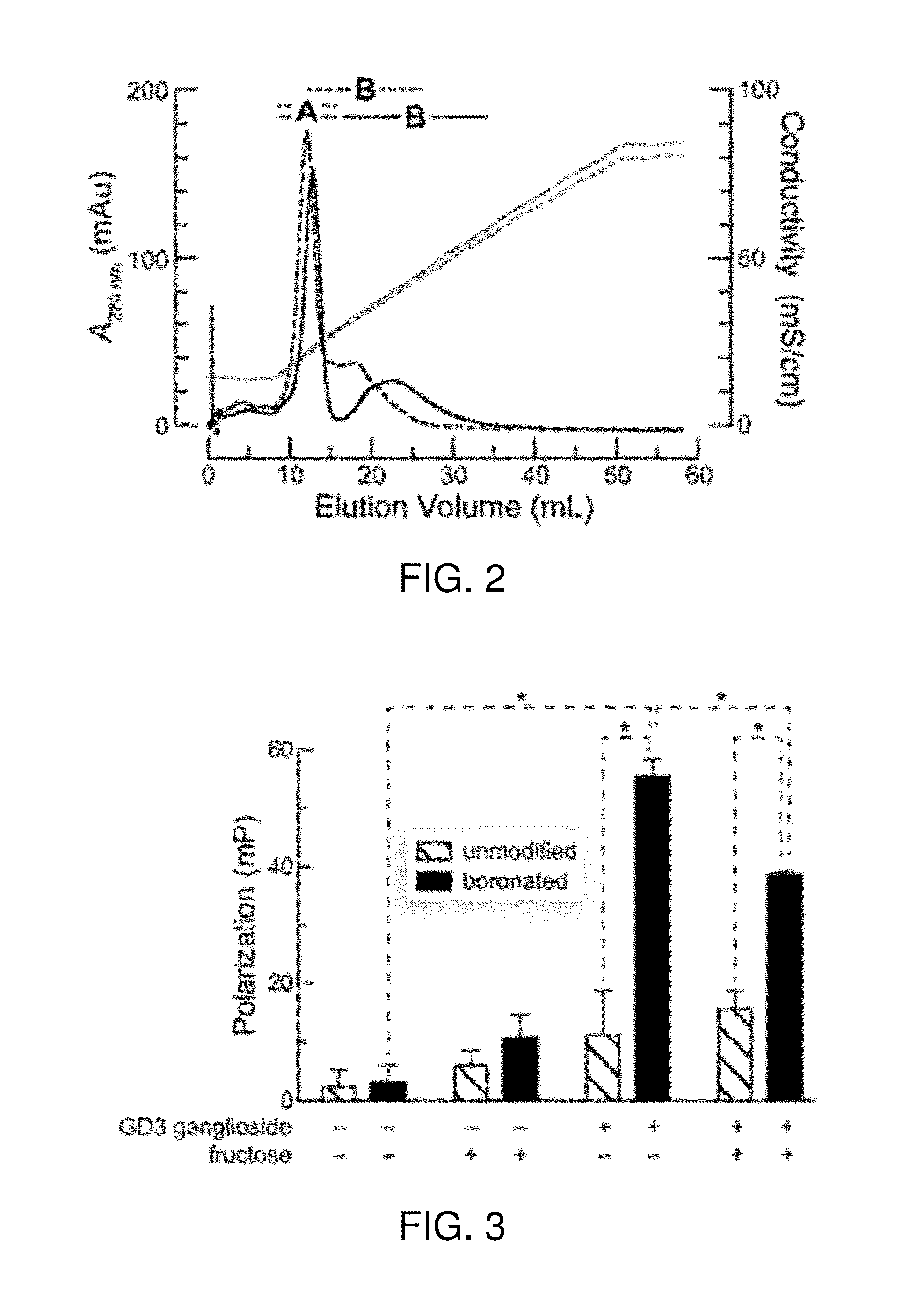Bioreversible boronates for delivery of molecules into cells
- Summary
- Abstract
- Description
- Claims
- Application Information
AI Technical Summary
Benefits of technology
Problems solved by technology
Method used
Image
Examples
example 1
Material and Methods
Materials:
[0279]N-Acetylneuraminic acid was from Carbosynth (Berkshire, UK). Phenylboronic acid, 2-hydroxymethylphenylboronic acid, and 5-amino-2-hydroxymethylphenylboronic acid were from Combi-Blocks (San Diego, Calif.). BODIPY® FL, STP ester was from Molecular Probes (Eugene, Oreg.). [methyl-3H]Thymidine (6.7 Ci / mmol) was from Perkin-Elmer (Boston, Mass.). N-(3-Dimethylaminopropyl)-N′-ethylcarbodiimide hydrochloride (EDC) and wild-type RNase A (Type III-A) were from Sigma-Aldrich (St. Louis, Mo.) and used without further purification. Ribonuclease substrate 6-FAM-dArUdAdA-6-TAMRA was from Integrated DNA Technologies (Coralville, Iowa). Bovine Serum Albumin (BSA) was from Thermo Scientific (Rockfield, Ill.). Lysozyme, from chicken egg white (Sigma L6876) was from Sigma-Aldrich (St. Louis, Mo.) and used without further purification. Biotinylated peptide was purchased and custom synthesized from Biomatik (Cambridge, Ontario, Canada). NeutrAvidin, Fluorescein conju...
example 2
Determination of Ka Values by 1H NMR Spectroscopy
[0285]Methodology to determine the values of Ka for boronic acids and saccharides was adapted from work by Hall and coworkers. [13a, 13b]
[0286]A boronic acid (B) and a saccharide (S) were assumed to bind in one modality, B·S:
B+S⇄B·SKa=[B·S][B][S]
[0287]The [B·S] / [B] ratio was determined by the integration of aryl protons of the boronic acid.saccharide complex and the free boronic acid. The individual [B], [B—S], and [S] can be calculated from eq. 1-3.
[B·S]+[B]=[BT][B·S][B]+1=[BT][B][B]=[BT][B·S][B]+1eq.1[B·S]=[B·S][B][B],where[B]iscalculatedfromeq.1[B·S]+[S]=[ST]eq.2[S]=[ST]-[B·S],where-[B·S]iscalculatedfromeq2eq.3
[0288]Each value of Ka arose from at least two independent experiments with freshly prepared solutions, and each experiment consisted of a titration with 6-9 different concentrations.
[0289]All NMR spectra were analyzed with Topspin 3.0 software from Bruker AXS. NMR experiments were done in a 0.10 M NaH2PO4 buffer, pH 7.4, con...
example 3
Conjugation of 5-Amino-2-Hydroxymethylphenylboronic Acid to RNase A Generating Benzoboroxole-Boronated RNase A
[0306]To display benzoboroxole moieties on RNase A, 5-amino-2-hydroxymethyl-phenylboronic acid (1) was conjugated to protein carboxyl groups by condensation using a carbodiimide:
Also see Scheme 1 (FIG. 1A). As noted below of the 11 carboxyl groups of RNase A, on average 5.7±1.6 were condensed with benzoboroxole as determined by mass spectrometry.
[0307]5-Amino-2-hydroxymethylphenylboronic acid (1, 320 mg, 1.70 mmol) was added to 30 mL of distilled, deionized H2O, and the resulting solution was adjusted to pH 5.0 with NaOH. To this solution was added RNase A (200 mg, 15 μmol), followed by EDC (640 mg, 3.30 mmol), and the pH was adjusted again to 5.0 with NaOH. The reaction mixture was incubated at ambient temperature overnight on a nutating mixer by BD (Franklin Lakes, N.J.). Additional EDC (360 mg, 1.9 mmol) was added, and the solution was incubated at the same conditions for...
PUM
 Login to View More
Login to View More Abstract
Description
Claims
Application Information
 Login to View More
Login to View More - R&D
- Intellectual Property
- Life Sciences
- Materials
- Tech Scout
- Unparalleled Data Quality
- Higher Quality Content
- 60% Fewer Hallucinations
Browse by: Latest US Patents, China's latest patents, Technical Efficacy Thesaurus, Application Domain, Technology Topic, Popular Technical Reports.
© 2025 PatSnap. All rights reserved.Legal|Privacy policy|Modern Slavery Act Transparency Statement|Sitemap|About US| Contact US: help@patsnap.com



